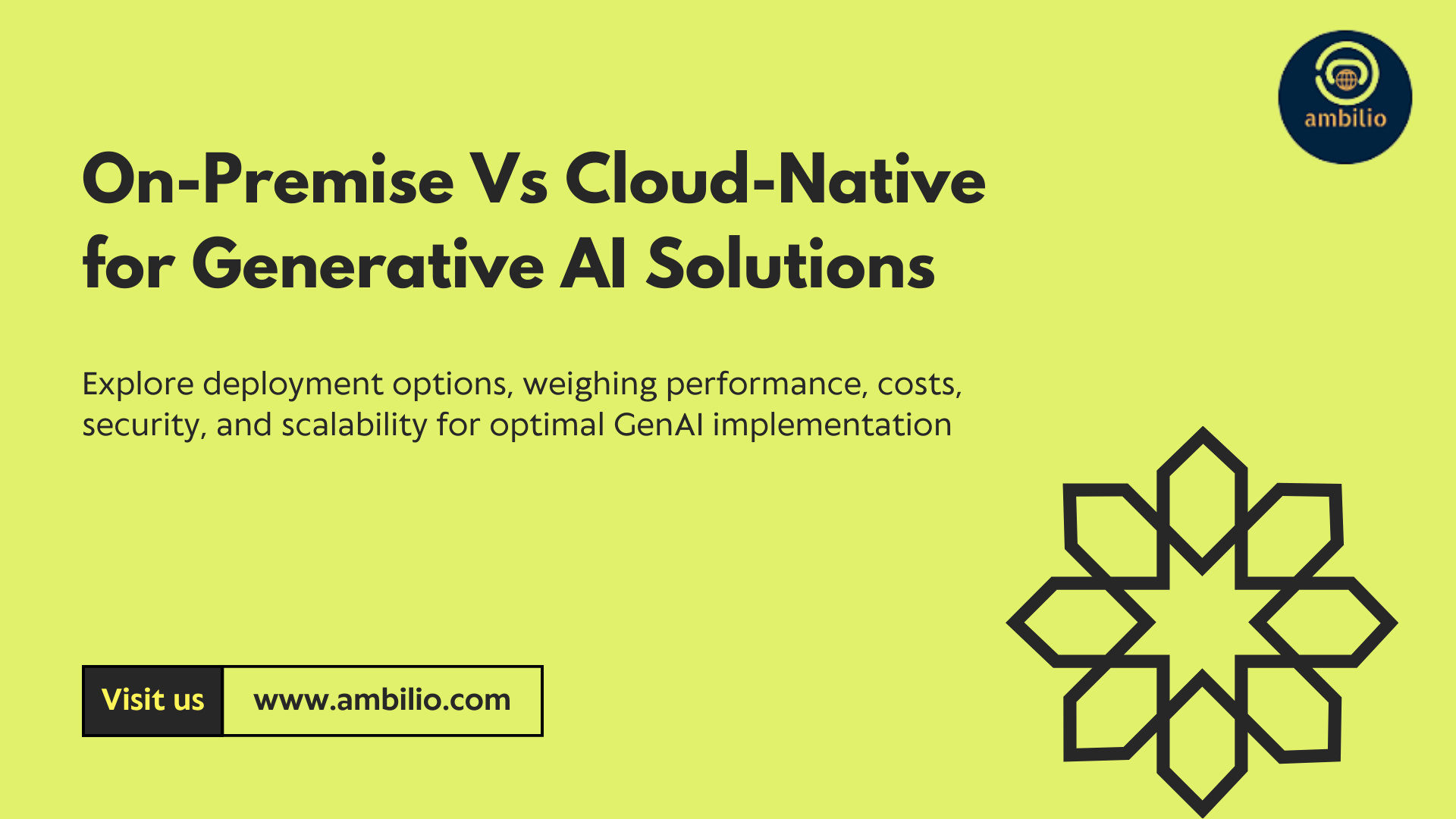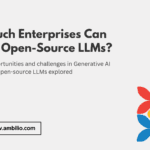Generative AI has emerged as a groundbreaking technology, revolutionizing various industries with its ability to create content, solve complex problems, and automate tasks. As organizations seek to implement generative AI solutions, they face a crucial decision in the realm of ‘On-Premise Vs Cloud-Native for Generative AI’: should they deploy these systems on-premise or opt for cloud-native solutions? This article explores the key differences, advantages, and challenges of both approaches in the context of On-Premise Vs Cloud-Native for Generative AI, helping decision-makers choose the most suitable option for their specific needs. The On-Premise Vs Cloud-Native for Generative AI debate is central to shaping an organization‘s AI strategy and infrastructure choices.
Understanding On-Premise and Cloud-Native Solutions
Before diving into the comparison, it’s essential to understand what these two deployment models entail. On-premise solutions involve installing and running AI systems on the organization’s own hardware and infrastructure. In this model, data and computing resources are managed locally within the company’s physical premises, giving the organization full control over the hardware, software, and data.
On the other hand, cloud-native solutions are deployed and operated on cloud platforms provided by third-party vendors. Computing resources are accessed remotely via the internet, with the cloud provider managing the underlying infrastructure while the organization focuses on using the AI services.
Key Factors to Consider
When deciding between on-premise and cloud-native solutions for generative AI, several factors come into play. Let’s explore these factors in detail to provide a comprehensive understanding of both options.
Performance and Scalability
On-premise solutions offer predictable performance as hardware resources are dedicated to the organization’s specific needs. However, scaling these systems can be challenging and often requires significant investment in new hardware and infrastructure. The performance of on-premise solutions is ultimately limited by the organization’s available computing power.
Cloud-native solutions, in contrast, are easily scalable to meet changing demands. They provide access to vast computing resources for handling large-scale AI workloads, allowing organizations to quickly ramp up their capabilities as needed. However, cloud solutions may face potential latency issues depending on the quality of the internet connection, which could impact real-time applications.
Cost Considerations
The cost structure of on-premise vs cloud-native for generative AI solutions differs significantly. On-premise deployments typically involve high upfront costs for hardware, software licenses, and infrastructure setup. Organizations must also factor in ongoing expenses for maintenance, upgrades, and energy consumption. Despite these initial investments, on-premise solutions may offer lower long-term costs for organizations with stable, predictable AI workloads.
Cloud-native solutions, on the other hand, require lower initial investment as organizations can avoid substantial infrastructure costs. Many cloud providers offer pay-as-you-go pricing models, providing flexibility and allowing companies to scale their expenses based on usage. However, costs can escalate quickly for intensive AI workloads or as usage increases, potentially leading to higher long-term expenses compared to on-premise solutions.
Security and Data Privacy
Security and data privacy are critical concerns when implementing generative AI solutions. On-premise deployments offer full control over data and security measures, making them suitable for organizations with strict data sovereignty requirements. With data stored locally, the risk of external data breaches is reduced, and companies can implement tailored security protocols that align with their specific needs and compliance requirements.
Cloud-native solutions rely on the security measures implemented by the cloud provider. While leading cloud providers invest heavily in security and often offer robust protection, organizations must trust third parties with their sensitive data. This can be a concern for companies in highly regulated industries or those dealing with particularly sensitive information. However, cloud providers often have access to more advanced security technologies and expertise than individual organizations can maintain in-house.
Flexibility and Innovation
Cloud-native solutions often have an edge when it comes to flexibility and access to cutting-edge innovations. Cloud providers frequently update their services with the latest AI technologies, allowing organizations to quickly adopt new features and capabilities without the need for significant infrastructure changes. This agility can be particularly valuable in the fast-paced world of AI, where new techniques and models are constantly emerging.
On-premise solutions, while offering greater control, may lag behind in terms of access to the latest innovations. Upgrading on-premise systems to incorporate new AI technologies can be time-consuming and costly, potentially putting organizations at a competitive disadvantage in rapidly evolving markets.
Customization and Integration
Organizations with unique or highly specialized AI requirements may find on-premise solutions more suitable for deep customization. On-premise deployments allow for fine-tuned control over every aspect of the AI system, from hardware optimization to software customization. This level of control can be crucial for organizations with complex integration requirements or those operating in niche industries with specific AI needs.
Cloud-native solutions, while offering a wide range of pre-built AI services and tools, may have limitations when it comes to deep customization. However, many cloud providers are increasingly offering flexible platforms that allow for significant customization and integration with existing systems, bridging the gap between cloud and on-premise capabilities.
Compliance and Regulatory Considerations
Regulatory compliance is a critical factor for many organizations, particularly those in industries such as healthcare, finance, and government. On-premise solutions can offer advantages in meeting strict compliance requirements, as organizations have complete control over data handling, storage, and processing. This control can be crucial for adhering to regulations such as GDPR, HIPAA, or industry-specific data protection laws.
Cloud-native solutions have made significant strides in addressing compliance concerns, with many providers offering specialized services designed to meet various regulatory requirements. However, organizations must carefully evaluate cloud providers’ compliance certifications and ensure that their chosen solution aligns with all applicable regulations.
Talent and Expertise Requirements
The choice between on-premise vs cloud-native for generative AI solutions also impacts the talent and expertise required to manage and maintain the AI systems. On-premise deployments typically require a team of skilled professionals to handle hardware maintenance, software updates, security, and overall system management. This can be challenging and costly, especially given the current shortage of AI and machine learning experts.
Cloud-native solutions can alleviate some of these talent requirements, as the cloud provider handles much of the underlying infrastructure management. This allows organizations to focus their resources on developing AI applications and deriving value from the technology, rather than managing the infrastructure. However, expertise is still required to effectively leverage cloud-based AI services and ensure optimal performance and cost-efficiency.
Final Words
The decision between on-premise vs cloud-native for generative AI solutions is not a one-size-fits-all choice. Each approach offers distinct advantages and challenges that must be carefully weighed against an organization’s specific needs, resources, and long-term goals.
On-premise solutions offer greater control, potentially lower long-term costs for stable workloads, and advantages in meeting strict security and compliance requirements. However, they require significant upfront investment and may limit an organization’s ability to quickly scale or adopt the latest AI innovations.
Cloud-native solutions provide scalability, flexibility, and access to cutting-edge AI technologies without the need for substantial infrastructure investments. They can accelerate time-to-market and allow organizations to focus on AI application development rather than infrastructure management. However, they may pose challenges in terms of data privacy, long-term costs for intensive workloads, and deep customization.
Ultimately, many organizations may find that a hybrid approach, combining elements of both on-premise and cloud-native solutions, offers the best of both worlds. This approach allows companies to keep sensitive workloads on-premise while leveraging the scalability and innovation of cloud services for other applications.
As the field of generative AI continues to evolve rapidly, organizations must remain agile and open to adjusting their deployment strategies. Regular reassessment of the balance between on-premise and cloud-native solutions will be crucial to ensuring that AI implementations continue to meet business needs effectively and efficiently in the long term.



